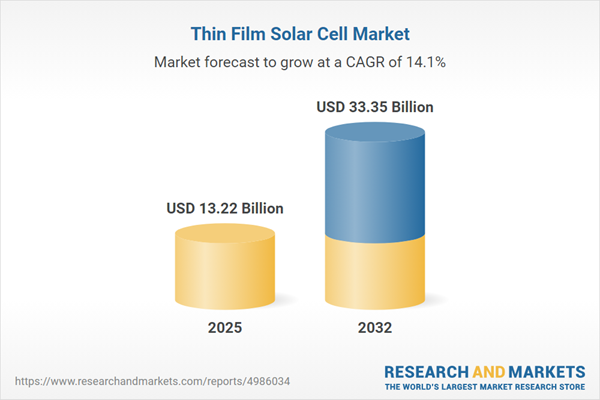Speak directly to the analyst to clarify any post sales queries you may have.
The thin film solar cell market is at the forefront of the global renewable energy shift, offering adaptable solutions for decarbonization and modern infrastructure. With evolving technologies and market drivers shaping its trajectory, this sector provides senior decision-makers with actionable strategies and data-driven insights for sustainable growth.
Market Snapshot: Thin Film Solar Cell Market Growth and Outlook
The Thin Film Solar Cell Market grew from USD 11.60 billion in 2024 to USD 13.22 billion in 2025. It is expected to continue growing at a CAGR of 14.10%, reaching USD 33.35 billion by 2032. Market momentum is driven by rapid innovation, prioritization of renewable energy, and enhanced cost-efficiency across application areas. Ongoing regulatory support and diversified installations keep the competitive landscape dynamic as demand intensifies within industrial, commercial, and residential sectors.
Scope & Segmentation
This report delivers in-depth analysis covering the following segments and regional outlooks, enabling precise strategic planning within the thin film solar cell sector:
- Technology: Amorphous Silicon, Cadmium Telluride, Copper Indium Gallium Selenide
- Application: Commercial (Carport, Rooftop), Residential (Building Integrated, Rooftop), Utility (Floating Mount, Ground Mount)
- Substrate: Glass, Metal Foil, Plastic
- Cell Type: Bifacial, Monofacial
- Efficiency Range: 10 to 15%, Above 15%, Below 10%
- Mount Type: Floating Mount, Ground Mount, Roof Mount
- Packaging: Glass Glass, Glass Polymer
- Sales Channel: Aftermarket, Direct, OEM
- Regions: Americas (United States, Canada, Mexico, Brazil, Argentina, Chile, Colombia, Peru), Europe, Middle East & Africa (United Kingdom, Germany, France, Russia, Italy, Spain, Netherlands, Sweden, Poland, Switzerland, United Arab Emirates, Saudi Arabia, Qatar, Turkey, Israel, South Africa, Nigeria, Egypt, Kenya), Asia-Pacific (China, India, Japan, Australia, South Korea, Indonesia, Thailand, Malaysia, Singapore, Taiwan)
- Major Companies: Hanergy Thin Film Power Group Co., Ltd., Solar Frontier K.K., Sharp Corporation, Panasonic Holdings Corporation, AVANCIS GmbH, Kaneka Corporation, S-Energy Co., Ltd., Ascent Solar Technologies, Inc., Heliatek GmbH, Flisom AG
Key Takeaways for Senior Decision-Makers
- The thin film solar cell market benefits from ongoing advancements in material science, enabling higher efficiency and integration into diverse environments.
- Flexible and lightweight module designs allow adoption across building facades, carports, floating arrays, and other non-traditional applications.
- Strategic collaborations among policymakers, manufacturers, and research institutions expedite innovation cycles and accelerate market penetration.
- Manufacturers focus on product modularity and supply chain adaptability, enhancing operational resilience amid shifting trade policies.
- Circular economy initiatives, such as material recycling and extended producer responsibility, are increasingly central to corporate sustainability strategies.
- Digital platforms delivering analytics and remote asset management are creating opportunities for lifecycle services and enhanced project return on investment.
Tariff Impact: U.S. Policy Influence on Global Supply Chains
United States tariff measures introduced in 2025 have compelled industry participants to reevaluate sourcing, production, and cost structures. These policy shifts prompted manufacturers to scale domestic fabrication, diversify procurement channels, and redesign products for modular compliance. As a result, stakeholders have prioritized operational agility and localized investment to mitigate exposure to regulatory volatility, influencing both global and regional supply strategies.
Research Methodology & Data Sources
This report uses a rigorous research approach that integrates primary interviews with executives and industry experts, combined with secondary analysis of technical journals, company filings, and market white papers. All findings undergo comprehensive cross-verification and triangulation to ensure accuracy, with regular updates reflecting sector developments.
Why This Report Matters
- Enables senior leaders to assess technology adoption, supply chain risks, and market positioning with actionable segment-level data.
- Supports investment and partnership decisions by providing clarity on evolving policy frameworks, application trends, and regional opportunities.
- Guides long-term planning and resource allocation aligned with sustainability goals and dynamic market demand.
Conclusion
The thin film solar cell market is advancing through adaptive strategies, technology innovation, and regional growth. This report delivers the insights and segmentation necessary for effective decision-making in a continually evolving landscape.
Additional Product Information:
- Purchase of this report includes 1 year online access with quarterly updates.
- This report can be updated on request. Please contact our Customer Experience team using the Ask a Question widget on our website.
Table of Contents
3. Executive Summary
4. Market Overview
7. Cumulative Impact of Artificial Intelligence 2025
Companies Mentioned
The companies profiled in this Thin Film Solar Cell market report include:- Hanergy Thin Film Power Group Co., Ltd.
- Solar Frontier K.K.
- Sharp Corporation
- Panasonic Holdings Corporation
- AVANCIS GmbH
- Kaneka Corporation
- S-Energy Co., Ltd.
- Ascent Solar Technologies, Inc.
- Heliatek GmbH
- Flisom AG
Table Information
| Report Attribute | Details |
|---|---|
| No. of Pages | 184 |
| Published | October 2025 |
| Forecast Period | 2025 - 2032 |
| Estimated Market Value ( USD | $ 13.22 Billion |
| Forecasted Market Value ( USD | $ 33.35 Billion |
| Compound Annual Growth Rate | 14.1% |
| Regions Covered | Global |
| No. of Companies Mentioned | 11 |









